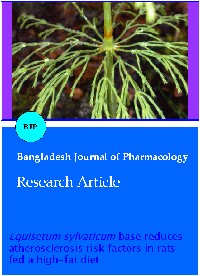Equisetum sylvaticum base reduces atherosclerosis risk factors in rats fed a high-fat diet
DOI:
https://doi.org/10.3329/bjp.v9i3.18593Keywords:
Equisetum sylvaticum, Hyperlipidemia, SODAbstract
We identify an Equisetum sylvaticum alkaloid (ESA) derived from E. hyemale, which has robust antihyperlipidemic effects in rats fed a high-fat diet. ESA was isolated from E. hyemale and identified by IR, 13C NMR and 1H NMR. Rats were induced to hyperlipidemia and subjected to ESA treatment. In hyperlipidemic model, fed with a high-fat diet, the blood levels of TC, TG and LDL-C were increased. The administration of ESA (20 or 40 mg/kg) to those rats significantly improved the HDL-C level and reduced the levels of TC, TG, LDL-C. The atherosclerosis index and atherosclerosis risk of these rats were significantly reduced by ESA. In addition, the administration of ESA in rats increased the activity of SOD and decreased the level of MDA. These results reveal the antihyperlipidemic and anti-oxidative effects of ESA in vivo.
Downloads
440
132 Read
7
References
Asdonk T, Motz I, Werner N, Coch C, Barchet W, Hartmann G, Nickenig G, Zimmer S. Endothelial RIG-I activation impairs endothelial function. Biochem Biophys Res Commun. 2012; 420: 66-71.
Ding Z, Liu S, Wang X, Khaidakov M, Dai Y, Mehta JL. Oxidant stress in mitochondrial DNA damage, autophagy and inflammation in atherosclerosis. Sci Rep. 2013; 3: 1077.
Dobiasova M, Frohlich J. The plasma parameter log (TG/HDL-C) as an atherogenic index: Correlation with lipoprotein particle size and esterification rate in apoB-lipoprotein-depleted plasma (FER(HDL)). Clin Biochem. 2001; 34: 583-88.
Filippatos TD. A review of time courses and predictors of lipid changes with fenofibric acid-statin combination. Cardiovasc Drugs Ther. 2012; 26: 245-55.
Haas MJ, Mooradian AD. Inflammation, high-density lipoprotein and cardiovascular dysfunction. Curr Opin Infect Dis. 2011; 24: 265-72.
Hadi NR, Yousif NG, Abdulzahra MS, Mohammad BI, Al-Amran FG, Majeed ML, Yousif MG. Role of NF-kappabeta and oxidative pathways in atherosclerosis: Cross-talk between dyslipidemia and Candesartan. Cardiovasc Ther. 2013; 31: 381-87.
Kitamura A, Noda H, Nakamura M, Kiyama M, Okada T, Imano H, Ohira T, Sato S, Yamagishi K, Iso H. Association between non-high-density lipoprotein cholesterol levels and the incidence of coronary heart disease among Japanese: The Circulatory Risk in Communities Study (CIRCS). J Atheroscler Thromb. 2011; 18: 454-63.
Li H, Wang P, Liu Q, Cheng X, Zhou Y, Xiao Y. Cell cycle arrest and cell apoptosis induced by Equisetum hyemale extract in murine leukemia L1210 cells. J Ethnopharmacol. 2012; 144: 322-27.
Mani S, Li H, Untereiner A, Wu L, Yang G, Austin RC, Dickhout JG, Lhoták Š, Meng QH, Wang R. Decreased endogenous production of hydrogen sulfide accelerates atherosclerosis. Circulation 2013; 127: 2523-34.
McCrindle BW, Urbina EM, Dennison BA, Jacobson MS, Steinberger J, Rocchini AP, Hayman LL, Daniels SR. Drug therapy of high-risk lipid abnormalities in children and adolescents: A scientific statement from the American Heart Association Atherosclerosis, Hypertension, and Obesity in Youth Committee, Council of Cardiovascular Disease in the Young, with the Council on Cardiovascular Nursing. Circulation 2007; 115: 1948-67.
Mohania D, Kansal VK, Shah D, Nagpal R, Kumar M, Gautam SK, Singh B, Behare PV. Therapeutic effect of probiotic dahi on plasma, aortic, and hepatic lipid profile of hypercholesterolemic rats. J Cardiovasc Pharmacol Ther. 2013; 18: 490-97.
Singh P, Mann KA, Mangat HK, Kaur G. Prolonged glutamate excitotoxicity: Effects on mitochondrial anti-oxidants and anti-oxidant enzymes. Mol Cell Biochem. 2003; 243: 139-45.
Tobert JA. Lovastatin and beyond: The history of the HMG-CoA reductase inhibitors. Nat Rev Drug Discov. 2003; 2: 517-26.
Vaidya AD, Vaidya R. Reactive oxygen species, anti-oxidant enzymes and smoldering chronic inflammation: Relevance to diabetes mellitus, atherosclerosis, and menopausal metabolic syndrome. J Midlife Health. 2011; 2: 49-50.
Vijayakumar RS, Surya D, Nalini N. Anti-oxidant efficacy of black pepper (Piper nigrum L.) and piperine in rats with high-fat diet induced oxidative stress. Redox Rep. 2004; 9: 105-10.
Wu WY, Wang YP. Pharmacological actions and therapeutic applications of Salvia miltiorrhiza depside salt and its active components. Acta Pharmacol Sin. 2012; 33: 1119-30.
Xu CF, Bian XY, Qu SM, You LH, Qi ZM, Cheng W, Liu XJ, Liu WZ, Ren SJ. [Effect of Equisetum hyemale on experimental hyperlipemia in rats and its toxic test]. Zhongguo Zhong Yao Za Zhi. 1993; 18: 52-53.
Yancey PG, Bortnick AE, Kellner-Weibel G, de la Llera-Moya M, Phillips MC, Rothblat GH. Importance of different pathways of cellular cholesterol efflux. Arterioscler Thromb Vasc Biol. 2003; 23: 712-19.
Zelko IN, Mariani TJ, Folz RJ. Superoxide dismutase multigene family: A comparison of the CuZn-SOD (SOD1), Mn-SOD (SOD2), and EC-SOD (SOD3) gene structures, evolution, and expression. Free Radic Biol Med. 2002; 33: 337-49.
Zeng Y, Song JX, Shen XC. Herbal remedies supply a novel prospect for the treatment of atherosclerosis: A review of current mechanism studies. Phytother Res. 2012; 26: 159-67.

Published
How to Cite
Issue
Section
License
Authors who publish with this journal agree to the following terms:
- Authors retain copyright and grant the journal right of first publication with the work simultaneously licensed under a Creative Commons Attribution License that allows others to share the work with an acknowledgement of the work's authorship and initial publication in this journal.
- Authors are able to enter into separate, additional contractual arrangements for the non-exclusive distribution of the journal's published version of the work (e.g., post it to an institutional repository or publish it in a book), with an acknowledgement of its initial publication in this journal.
- Authors are permitted and encouraged to post their work online (e.g., in institutional repositories or on their website) prior to and during the submission process, as it can lead to productive exchanges, as well as earlier and greater citation of published work (See The Effect of Open Access).
